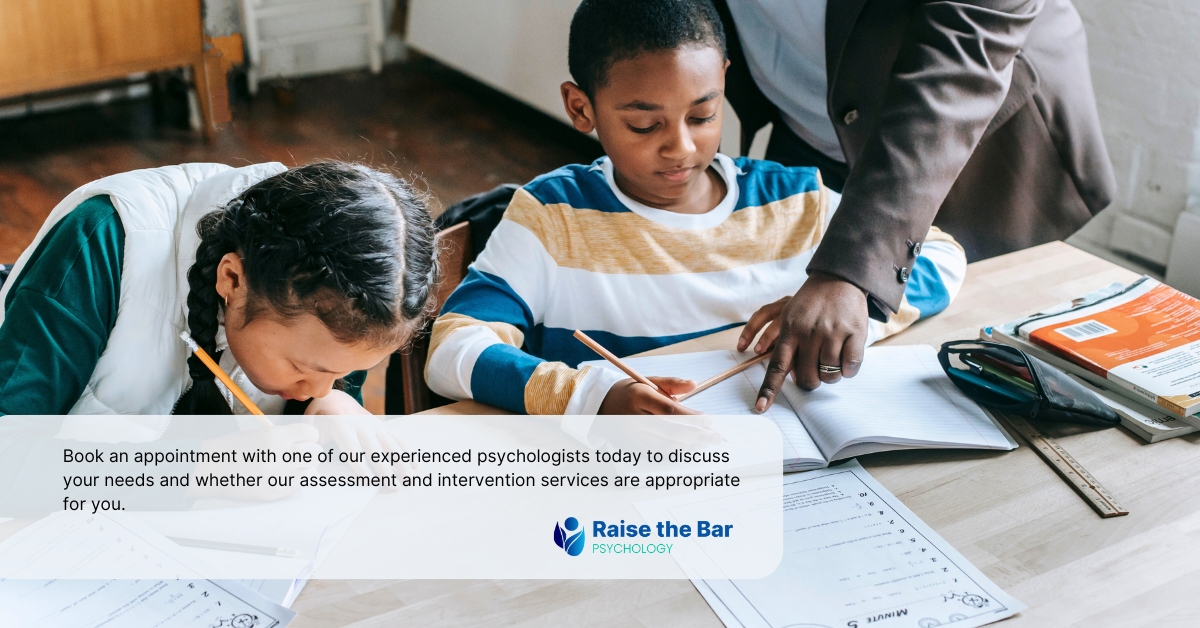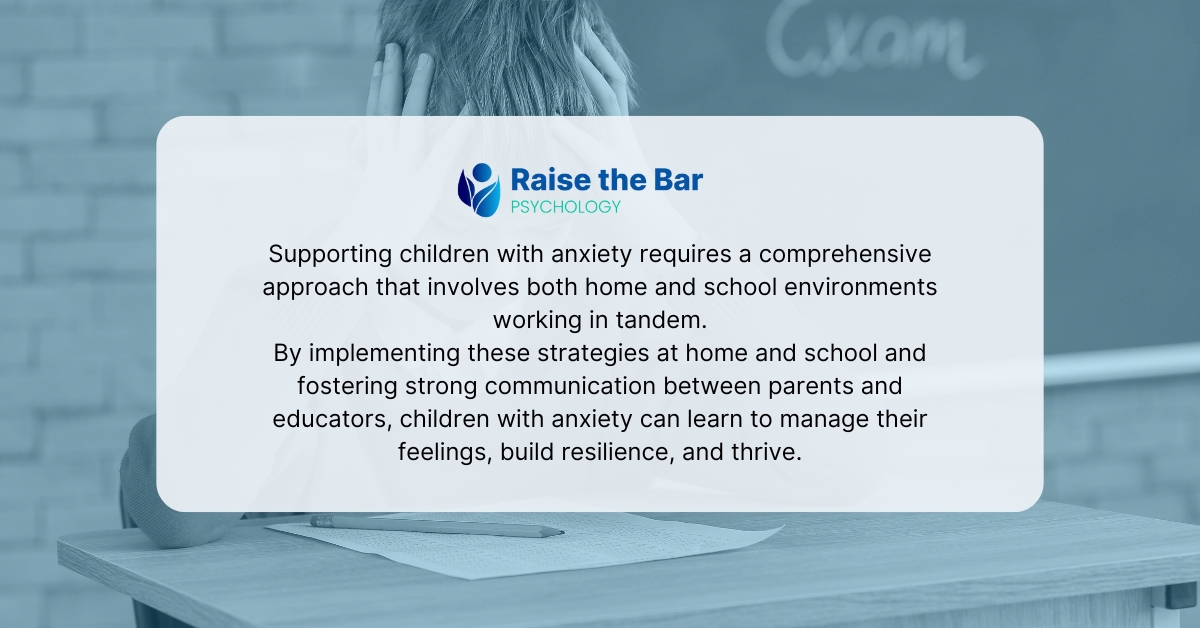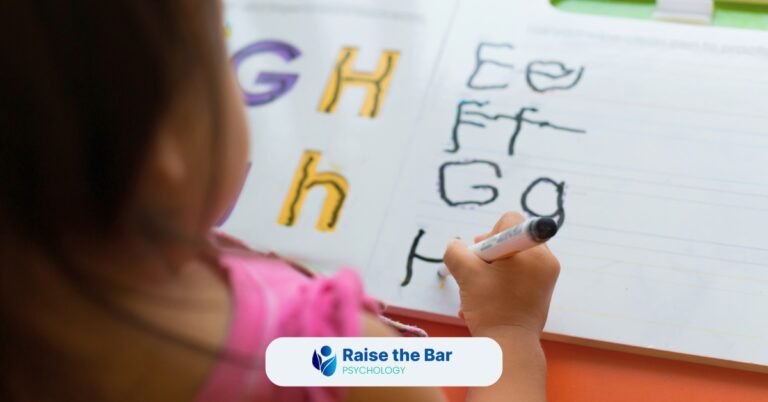Are you looking for ways to help your child cope with anxiety? Many parents struggle to find effective tools and strategies for supporting their children at home and school. Anxiety in children is increasingly common and can impact their academic performance and social interactions.
Parents and educators need to recognise and understand these challenges. By creating a strong support system and adopting targeted strategies, you can help your child manage anxiety and thrive.
Effective strategies for supporting children with anxiety at home
1. Open communication and validation
- Listen actively: Encourage your child to talk about their worries without dismissing their feelings. Ask open-ended questions like, “How do you feel about [situation]?” rather than leading ones.
- Validate their feelings: Let them know it’s okay to feel scared or worried. Phrases like “I know this is hard for you” or “It’s okay to feel scared” can be helpful. Avoid saying “just get over it” or “there’s nothing to worry about.”
- Explain anxiety: Help your child understand what anxiety is – a natural reaction to stress that can affect thoughts, feelings, and behaviour. Use analogies like an “overactive fire alarm” or a “wave that builds and goes away“.
- Limit reassurance, encourage coping: While validating, avoid over-reassuring. Instead, express confidence that they can cope with and reduce their anxiety, with your support.
- Don’t reinforce fears: Avoid taking them out of situations just because they’re anxious, as this can teach them that avoidance is a good way to cope.
2. Teach coping skills
- Relaxation techniques: Teach deep breathing exercises (e.g., “belly breathing,” “blowing out birthday candles”), mindfulness, or progressive muscle relaxation.
- Positive self-talk: Help them reframe negative thoughts with positive affirmations like, “I can try this” or “I will do my best“.
- Worry time/worry box: Designate a specific “worry time” (10-15 minutes) or a “worry box” where they can write or draw their worries and then “put them away.”
- Problem-solving: Work together to identify anxiety triggers and find solutions. For example, if they’re worried about a sleepover, help them make a plan involving a close friend or trusted adult.
- Gradual exposure (facing fears): Gently encourage your child to gradually face the situations they fear. Praise and reward their brave behaviour, focusing on their efforts to cope, not just the outcome.
3. Establish healthy routines and environments
- Predictable routines: Children thrive on consistency. Create regular schedules for meals, bedtime, and homework to provide a sense of security. Prepare for school the night before (clothes, bags).
- Healthy lifestyle: Ensure they get plenty of sleep (9-12 hours for school-aged, 8-10 for teens), eat healthy meals, and engage in at least an hour of physical activity daily.
- Limit media exposure: Moderate access to news and social media, and avoid scary or violent TV shows/games.
- Dedicated connection time: Set aside one-on-one time daily, even just 10 minutes, without distractions. This strengthens your bond and provides opportunities for them to open up.
- Model healthy coping: Show your child how you manage your stress and anxiety in a healthy way.
4. Seek professional help if needed
- If anxiety is long-lasting (more than two weeks), increasing, impacting their daily functioning (home, school, community), or accompanied by physical symptoms, consult your GP or a mental health professional. Cognitive behavioural therapy (CBT) is often effective for anxiety in children.
Effective strategies for teachers supporting children with anxiety at school
1. Create a supportive classroom environment
- Understand the impact of anxiety: Recognise that anxiety can affect a child’s attention span, working memory, willingness to take risks, and class participation.
- Designated calm spaces: Offer a quiet or safe space in the classroom where anxious students can decompress if feeling overwhelmed.
- Visual supports and predictability: Use visual schedules and transition warnings (e.g., timers, verbal countdowns) to reduce uncertainty and help children prepare for changes in routine.
- Noise reduction: Implement techniques like headphones or designated quiet areas to help students sensitive to noise.
- Foster social connections: Encourage participation in group discussions and extracurricular activities, and support positive peer interactions.
2. Direct support and skill building
- Teach coping strategies: Explicitly teach deep breathing, mindfulness, and other relaxation techniques that students can use in class.
- Help identify triggers: Work with the student to understand what situations or times make them anxious.
- Validate and normalise: Acknowledge their anxiety without judgement. Let them know it’s okay to feel worried and that you are there to help.
- Break down tasks: For anxious students, large assignments can be overwhelming. Break them into smaller, manageable steps.
- Positive reinforcement: Praise and acknowledge all efforts to manage anxiety and engage in challenging situations, not just perfect outcomes.
- Flexible thinking: Teach children to brainstorm different solutions to problems and consider pros and cons.
3. Collaboration with parents
- Open and regular communication: Establish clear communication channels (e.g., communication notebooks, email, scheduled meetings) with parents to share observations about the child’s behaviour, academic progress, and emotional well-being.
- Share insights: Teachers can offer insights into how the child is coping in the school environment, while parents can provide context from home life.
- Consistent strategies: Work together to ensure consistent strategies for managing anxiety are used both at home and at school. This includes coordinating behavioural approaches and transition planning.
- Early intervention: Share concerns promptly so that interventions can be put in place before issues escalate.
- Involve the child: Where appropriate, involve the child in discussions about their anxiety and what strategies they find helpful.

Final thoughts
Supporting children with anxiety requires a comprehensive approach that involves both home and school environments working in tandem.
By implementing these strategies at home and school and fostering strong communication between parents and educators, children with anxiety can learn to manage their feelings, build resilience, and thrive.
Book an appointment with one of our experienced psychologists today to discuss your needs and whether our assessment and intervention services are appropriate for you.
Author
-

Dr Kate Jacobs
Director / Educational and Developmental PsychologistDr Kate Jacobs completed a combined PhD/Masters in Educational and Developmental Psychology at Monash University in 2013. She was awarded the Mollie Holman Doctoral Medal for the best PhD thesis in the Education Faculty for the year.




